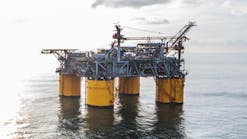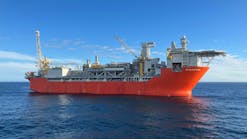William J. M. Steel, Robert Inglis
BP Exploration
London
A major new 36-in., oil-export pipeline has been installed in the North Sea between the Forties field and Cruden Bay on the U.K. mainland.
Designing and installing the line involved solving problems caused by sandwaves in the nearshore segment of the route.
PRESSURE REDUCTIONS
The Forties pipeline system covers offshore and land pipelines between the Forties field and the Firth of Forth tanker loading terminal and incorporates oil transportation, stabilization-gas separation, processing, and storage.
The pipeline is used as part of an integrated oil and gas liquid gathering system from the central North Sea (Fig. 1). Oil and gas liquids from other offshore fields are connected by subsea pipelines and risers to the Forties Charlie platform.
Inspection of the existing 32-in. offshore pipeline had indicated signs of corrosion which would prevent the system from operating economically as future demands increased. In addition, when the line was commissioned in 1975, it was not envisioned that it would eventually carry crude from several other fields, which will come onstream this decade.
The decision to lay a new 36-in. sealine reflects this need for increased capacity to ensure that the Forties pipeline system continues as a major carrier of oil and gas liquids well into the next century.
Corrosion monitoring and inspection of the 32-in. line led to sections of the topside pipework being replaced in 1985 and the top section of the riser in 1987. The corrosion also resulted in the pipeline maximum allowable operating pressure (MAOP) being limited to 115 barg (1,668 psig) from 129 barg (1,871 psig).
During the replacement work, corrosion in the lower section of the riser was also identified. This led in 1988 to an intelligent-pig run through the pipeline with the British Gas instrument. The results prompted further derating of the pipeline MAOP to 103 barg (1,494 psig).
Two further intelligent-pig runs were made in 1989 to confirm the results and assess the corrosion rate.
The inspection showed significant general and pitting corrosion out to approximately 30 km (19 miles) from the Forties "C" platform (FC), becoming insignificant after 50 km (31 miles). Preferential corrosion of both the girth and longitudinal seam welds was detectable out to a point approaching 110 km (68 miles) from FC.
At its worst, the mean wall thickness was reduced by 2 mm (0.078 in.) with local wall thicknesses reduced by 4 mm (0.147 in.) for several pipe joints. One girth-weld defect was identified to have reduced local wall thickness by more than 6 mm (0.236 in.).
The corrosion damage has been attributed primarily to the presence of water containing carbon dioxide and forming carbonic acid.
The nature of the corroded surfaces also suggested that the effects of flow had been a major influence on the location and rate of attack. Other factors, including temperature, the characteristics of the produced waters, and the corrosion products were also thought to have contributed to the corrosion mechanisms.
Accelerated corrosion at welds was a direct result of galvanic corrosion between the weld, heat-affected zone, and parent material.
REPLACEMENT DECISION
The intelligent-pig runs had also confirmed that corrosion was continuing in the pipe line. It was clear that, while the line was fit for its original purpose, the corrosion would prevent the line from operating economically when future demand increased.
Given that likely trend, derating of the pipeline operating pressure was expected to affect capacity in late 1991.
Several options were therefore evaluated, including the following:
- Partial replacement of the existing line
- Complete replacement with a line of the same diameter
- Complete replacement with a 36-in. line.
The offshore construction market in 1991-92 favored an early decision and construction of the chosen option in 1990.
The most important factor in the decision became the operational downtime for partial replacement compared with complete replacement. A difference of some 14 days was estimated, sufficient to justify complete replacement.
From this point, throughput potential justified the incremental capital cost of increasing the line size to 36-in. OD.
The pipeline route from FC to the Cruden Bay terminal is 171 km (106 miles) long and comprises 168.5 km sealine and 2.5 km landline. With a 36-in. line, the capacity is increased to 950,000 b/d compared with 630,000 b/d for a 32-in. line.
The new 36-in. line was routed parallel to and in the same corridor with the 32-in. line. The nominal route centerline was 50 m (164 ft) north of the existing line.
This gave the laybarge sufficient room to work to its normal laying tolerance, allowed the barge anchors to be positioned astride the existing line without undue interference, and reduced the seabed area and thus interference with other users.
The pipeline route also necessitated the crossing of two existing lines-the 20-in. OD Fulmar-to-St. Fergus pipeline and the 30-in. OD Brae-to-FC pipeline.
For the former, two concrete sleepers provided initial support for the new pipeline.
But the soil conditions in the area of the Brae pipeline crossing made this option impractical. Instead, rock was dumped to form a causeway over which the line was laid. Finally, both crossings were rock dumped to provide long-term protection and stability.
LINEPIPE, INSTALLATION
After competitive tendering, Mannesmann AG received the contract for the supply of the linepipe. This was submerged-arc welded (SAW) pipe manufactured according to API 5L specification to grade X65 with a nominal 28.6 mm (1.125 in.) W.T.
Supplementary manufacturing requirements were also applied to meet BP's own quality assurance and quality-control standards. In view of the preferential weld corrosion in the existing pipeline, the linepipe manufacturer was required to use a longitudinal weld consumable which exhibited the desired cathodic weldment condition.
Mechanical and electrochemical tests guided selection of a suitable nickel-bearing consumable which was eventually used for the longitudinal welds most "at risk," that is, in the 85 km (53 miles) of line nearest FC.
Tackling preferential weld corrosion was only one element in a corrosion-management strategy developed to reduce future corrosion in the new line. The strategy also addressed controlling the level of corrosive substances entering the line and implementing and maintaining both an effective regime of inhibitor injection and a corrosion-monitoring program.
In addition, to limit corrosion, particularly during construction and testing, a liquid epoxy primer was applied to the internal surface of all linepipe.
The sealine was externally coated with a coal-tar enamel corrosion coat and concrete weight coating. The concrete thickness is generally 2 in. but was increased to 4 in. for the first 2.5 km (1.5 miles) from Cruden Bay to provide the necessary on-bottom stability during installation.
For long-term stability, the first 14.5 km (9 miles) of line out from Cruden Bay were trenched (Fig. 2 ) with the first 2 km (1.2 miles) also backfilled. Corrosion protection for the sealine is enhanced by sacrificial zinc anodes spaced along its length.
The landline was coated with coal-tar enamel and buried for its entire length with a minimum depth of cover of 1,200 mm (4 ft). The corrosion coating is supplemented by an impressed-current, cathodic-protection system.
ETPM's laybarge DLB 1601 fitted with the new Saturne 8T welding system installed the sealine. The Saturne system is an automated four-head, eight-torch, orbital MAG system (Fig. 3). It was used for main line root and fill passes. Capping runs were completed with innershield FCAW.
After resolution of the initial teething problems, the system proved to be capable of sustaining lay rates of 2.7 km/day (1.7 miles/day) and achieved a peak rate of 3.12 km (1.94 miles) in one day. Considering the pipeline diameter and wall thickness, it is an impressive feat to produce a completed weld, including radiography and field-joint coating, every 10 min.
As with the longitudinal welds, all girth-weld consumables were tested to ensure that they were not susceptible to preferential weld corrosion.
To allow future tie-ins to the pipeline, a 16-in. Inconelclad tee assembly and two in-line flanged spool pieces were installed with the line.
Installation of the new 36-in. riser and associated pipework presented the problems which normally occur when equipment is being retrofitted on an already congested platform.
For corrosion protection both the riser and tie-in spools were internally clad with 316L stainless steel.
For completion of the short onshore pipeline and terminal works at Cruden Bay, material delivery was the main problem.
The preference for through-conduit gate valves resulted in the impressive sight of two 36-in., 7-m (23 ft) high, 23-ton Grove valves (Fig. 4). But delivery of the second of these valves slipped because of cracking problems with the stellite facing of the gate.
This was remedied by a refacing with a modified grade of stellite which had a lower carbon content for greater ductility.
SANDWAVES, SPANNING
Significant sandwaves along the near-shore section of the sealine route presented a challenge for cost-effective installation.
These sandwaves were found to be up to 3-m (10 ft) high and covered an area between 5 and 30 km (3 and 19 miles) from the shore in water depths of between 50 and 100 m (164 and 328 ft; Fig. 5).
Where sandwaves or other bathymetric irregularities such as pockmarks or rock outcrops occur, a submarine pipeline will be discontinuously supported by the seabed. Consequently, freespans of significant length and off-bottom clearance may occur.
The imposed profile may induce unacceptable bending moments in the pipe while the spanning sections may be susceptible to flow-induced vibrational damage. Additionally, the spanning pipeline may present an obstruction to fishing activity and may hinder the passage of on-line trenching equipment such as ploughs and jet-sleds.
Small-diameter lines at elevated temperature may also be susceptible to buckling instability.
Through detailed analysis, the operator can define acceptance criteria, taking account of both dynamic and static loading conditions on isolated spans. In areas of multiple spans or complex seabed topography, a bottom-roughness analysis should be carried out to determine the bending moment distribution in the pipe.
Where spans do occur, a pipeline operator has two main options:
- Excavate the seabed at high spots and lower the pipeline to increase the support.
- Provide intermediate support to spanning line sections.
A range of methods can be used, the selection among which will depend on both commercial and technical factors. These include the number and severity of locations requiring remedial work, water depth, seabed nature, pipeline parameters, and schedule of construction operations.
As part of the normal design process, allowable freespan limits were calculated by ETPM with the traditional methods of vortex shedding induced vibration suppression and a limiting bending stress criterion.
Limiting span lengths were calculated for two conditions:
- As-laid, water-flooded condition-70 m (230 ft)
- Hydrotest, operation condition-65 m (213 ft).
At the time of contract award in June 1989, only limited survey information was available for the new route corridor. This was mainly drawn from the annual surveys of the 32-in. line which was shown to be partially buried and hence in a safe condition through the sandwave area.
While these surveys noted the presence of sandwaves, they gave no precise data on the profile along the new pipeline route.
ROUTE SURVEY
A dedicated route-corridor survey was performed in September 1989 and gave some indication of the severity of the problem.
In particular, three prominent sandwaves were observed 6, 8, and 10 km (3.7, 5.0, and 6.2 miles) from the shore, followed by a series of undulations between 18 and 30 km (11 and 19 miles) out.
The water depths in this area, 50-100 m (164-328 ft), were much greater than would normally be expected in regions of sandwave activity.
It was recognized that these sandwaves could lead to a considerable project cost escalation and potential delay.
A route profile assessment was conducted in tandem by ETPM and BP.
Bottom-roughness analyses were performed realistically to define the bending-moment distribution along the route centerline. ETPM used its mainframe computer-based OPLSWEEP program, while BP used the A. J. Palmer-developed PLUSONE ROUG program.
The former is able to model seabed elasticity effects, whereas the latter is a flexible PC-based program which was ultimately used to good effect offshore on the rectification spread.
Initial analysis led to minor route deviations which alleviated some of the worst areas, but the constraints of the existing pipeline limited the effectiveness of these adjustments.
The main conclusions at this stage were:
- The pipeline could be laid and water-filled without the need for prelay rectification work, except for the sandwave peak 8 km from shore where it appeared to be slightly overstressed in the water-filled condition.
- Post-lay remedial work would be required in a total of seven other locations.
- The acceptability of these and other locations was recognized to be very sensitive to even minor changes in the profile as could be expected from the normal installation tolerance (10 m from the route centerline) and localized settlement at support points.
For the now-defined workscope, ETPM performed an evaluation of potential rectification systems.
This evaluation indicated that the most cost-effective solution would be use of Alluvial Mining's Tramrod remotely operated, tracked suction dredger (Fig. 6) deployed from a dive-support vessel (DSV).
BP also employed A. J. Palmer & Associates to evaluate further the span limits. They concluded that use of fatigue limit state criteria and an allowable strain, rather than stress-based criterion, could increase the defined limits.
Of crucial importance, they showed that the sandwave 8 km from the beach could be tolerated during the installation phase. This information justified the decision to postpone remedial work until after pipelay.
This procedure represented a major breakthrough because of both the enormous cost estimated for prelay dredging ($9.5-12.5 million) and the lead time (6 months) necessary for modification of the dredgers to work beyond their normal waterdepth range.
SURVEY, RECTIFICATION
It was also agreed to use the Bathyscan 3D Mapping System within the prelay survey at the start of the construction season. The Bathyscan is a fish-mounted, interferometric swathe bathymetry system which gives a greater density of soundings compared with a conventional echo-sounder.
It provided a more detailed picture of the seabed, therefore, and allowed further scope for rerouting and more closely defining the extent of the post-lay rectification work.
The survey vessel Seaboard Invincible performed the Bathyscan survey of the sandwave zone in May 1990. The pipelay corridor was mapped in three passes, a width of 250 m over a 25 km length in just 24 hr. Each pass was correlated against adjacent passes applying positional and tidal corrections, and a detailed contour map was generated.
Profiles for several route options generated by Brown & Root survey and analyzed by ETPM produced the following conclusions:
- General features were consistent with the earlier survey and appeared to be consistent over the 20-m width of the lay corridor.
- Options for additional route deviations appeared limited. Features were more severe to the north, while the existing 32-in. line limited deviation to the south.
- Eleven areas were now predicted to require post-lay remedial work. Of these, three were within the trenching zone (up to 14.5 km out), and more extensive dredging would be necessary to open a corridor to permit passage of the trenching plough Land & Marine's PBPL spread. On this basis, a program of work for the Tramrod unit was prepared. The scheduling proved to be complex because the movements of lay, trench, survey, and diving spreads had to be coordinated to minimize downtime of each vessel.
The Tramrod unit was mobilized aboard the DSV Wilchief in June 1990. Support services included a saturation diving spread, a Genflo hand-dredging unit, a Digiquartz pressure transducer, and an observation ROV.
Initial as-laid survey data were supplied directly from the Seaboard Invincible acting in support of DLB 1601 and LM Balder trench barge. The as-laid profile was assessed directly by BP engineers on board the DSV with the PLUSONE ROUG program on a laptop computer.
The as-laid survey confirmed the major sandwave ridges and matched the predicted profile closely. At each worksite, the procedure was to conduct a Digiquartz survey of the pipeline before deploying the Tramrod/Genflo dredging units.
Diver spot measurements were taken as the work progressed. Upon completion, a confirmatory Digiquartz survey was carried out.
BP then analyzed the revised profile. At the most severe location 8 km (5 miles) from the shore, the pipeline spans were 100 m (328 ft) long, 2 m (6 ft) off bottom and 80 m (262 ft) long, 1.5 m (5 ft) off bottom, either side of the sandwave ridge.
The ridge was excavated to a maximum depth of 2 m (6 ft) over a plan area of 25 m x 15 m (82 x 48 ft). This effectively removed the spans and allowed the pipeline subsequently to be trenched to the 1 m (3 ft) cover specification.
Dredging and other dive support works were performed at six sites, and the work was completed in July 1990 without affecting the overall project schedule.
Copyright 1991 Oil & Gas Journal. All Rights Reserved.


